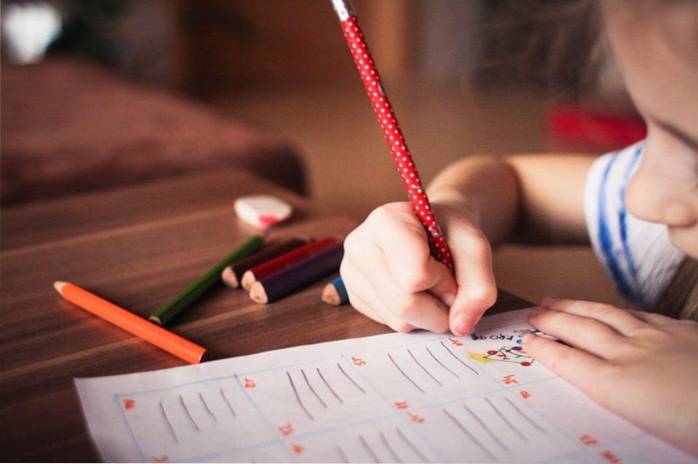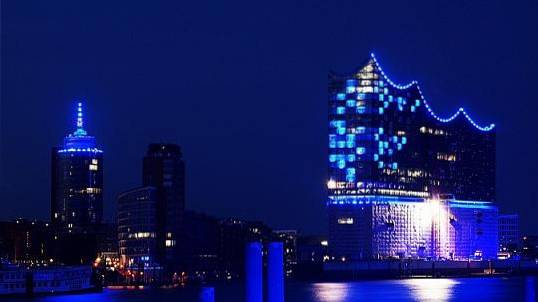
Types et exemples d'adaptations curriculaires

le Adaptations curriculaires (également appelées adaptations curriculaires) sont des outils utilisés en éducation pour aider les élèves ayant des besoins éducatifs spéciaux. En général, ils consistent à modifier des aspects du programme ou de la méthode d'enseignement, afin que les objectifs pédagogiques soient adaptés à tous les élèves..
L'un des principaux problèmes du système éducatif moderne est que, en devant utiliser un modèle standardisé pour tous les élèves, il ne prend pas en compte leurs différences individuelles. Des adaptations curriculaires permettraient de corriger dans une certaine mesure cette défaillance du système.

Contrairement à ce que l'on pense généralement, cet outil est applicable non seulement aux étudiants ayant de moins bons résultats scolaires, mais aussi à tous ceux qui ont des besoins spécifiques. Ces étudiants peuvent aller des personnes ayant un handicap physique à celles ayant des capacités mentales extraordinaires..
Index des articles
- 1 Types
- 1.1 Adaptations du programme pour accéder au programme
- 1.2 Adaptations individuelles du programme
- 1.3 Adaptations curriculaires pour les étudiants surdoués
- 2 exemples
- 2.1 Utilisation de différentes techniques d'évaluation
- 2.2 Changement du contenu à étudier
- 2.3 Extension du contenu
- 3 Références
Les types
Selon les aspects du programme éducatif qui sont modifiés, il existe différents formats d'adaptations curriculaires. Celles-ci évoluent entre deux extrêmes: d'une part, il y a les petits changements que les enseignants apportent dans leurs enseignements quotidiens, et d'autre part, les modifications qui changent de manière significative le programme se démarquent..
Il existe principalement trois types d'adaptations curriculaires: l'accès au programme, individuel et pour les étudiants hautement compétents.
Adaptations curriculaires pour l'accès au curriculum
Ce premier type d'adaptation curriculaire consiste à modifier certains aspects de la méthode d'enseignement, afin que les élèves présentant des particularités physiques ou cognitives puissent étudier le programme scolaire normal..
En général, ils sont utilisés pour rendre l'éducation plus accessible à certaines minorités, comme celles qui ont un certain type de déficience sensorielle ou motrice. À leur tour, ils peuvent être divisés en adaptations d'accès physique et d'accès à la communication.
Hébergement à accès physique
Ce sont tous ceux qui modifient certains aspects matériels de l'environnement éducatif pour en permettre l'accès aux personnes ayant des besoins spéciaux en ce sens..
Par exemple, l'inclusion de rampes ou d'ascenseurs pour les personnes en fauteuil roulant, de mobilier adapté ou l'inclusion de personnel de soutien dans les salles de classe pour aider les élèves ayant de graves problèmes de moteur est envisagée..
Adaptations d'accès à la communication
Ce sont tous les ajustements liés à différents matériels pédagogiques modifiés pour s'adapter à un certain groupe d'étudiants. Certains exemples seraient des livres écrits en braille pour les aveugles ou l'enregistrement audio de matériel scolaire pour les personnes dyslexiques..
Adaptations curriculaires individuelles
Ce type d'adaptation curriculaire est ce que la plupart des gens comprennent lorsqu'ils entendent parler de ce concept. C'est une série de changements dans le cursus pédagogique fait pour adapter les connaissances à acquérir au niveau de chaque élève.
La principale caractéristique de ce type d'adaptation curriculaire est qu'elle doit être réalisée individuellement pour chaque élève ayant des besoins éducatifs particuliers. En fonction de la profondeur des changements apportés, ils sont divisés en adaptations non significatives et adaptations significatives.
Adaptations non significatives (ACNS)
Ce sont des changements dans certains éléments de l'éducation qui ne sont pas liés à une modification profonde du contenu à étudier. Par exemple, ils pourraient avoir à voir avec le temps qu'un élève peut utiliser pour passer un examen, le type d'exercices qu'il doit effectuer ou la façon d'enseigner une leçon spécifique..
Dans certains cas, ils peuvent également être utilisés pour modifier le contenu à étudier par les élèves ayant des besoins spéciaux; mais si c'est le cas, ils ne devraient jamais avoir un retard de plus de deux cours par rapport à leurs pairs.
Dans un premier temps, ces adaptations doivent être utilisées dans pratiquement tous les cas, sauf si un étudiant individuel a besoin d'une aide très spécifique pour acquérir les connaissances de base.
Avec l'ACNS, l'étudiant peut toujours obtenir son diplôme d'études supérieures, car il répondrait aux exigences minimales d'enseignement.
Ajustements significatifs (ACS)
Ce sous-groupe d'adaptations curriculaires se caractérise par un changement profond du contenu à étudier par un étudiant. Pour être réalisés, ils nécessitent une évaluation psychopédagogique préalable des élèves, de manière à ce qu'ils puissent être parfaitement adaptés aux besoins individuels de la personne..
En raison des grands changements que ces adaptations impliquent pour les connaissances acquises par l'étudiant, il y a une grande controverse sur la question de savoir si ceux dans lesquels elles sont appliquées devraient être en mesure d'obtenir leur diplôme d'études. Pour cette raison, on essaie de ne pas les utiliser sauf dans les cas les plus extrêmes..
Certains des changements qui peuvent être introduits avec l'ACS seraient la modification d'éléments tels que les exigences d'apprentissage de base, les objectifs d'enseignement d'une matière spécifique ou les méthodes utilisées pour l'évaluation..
Adaptations curriculaires pour les étudiants surdoués
Bien qu'il s'agisse d'un groupe largement ignoré dans le secteur de l'éducation, les étudiants surdoués ont également besoin d'une modification du contenu éducatif pour atteindre leur plein potentiel..
Cela est principalement dû au fait qu'en suivant leurs pairs, ils ont tendance à devenir démotivés et à perdre toute motivation à prêter attention au contenu éducatif. Cela peut entraîner toutes sortes de problèmes, tels que des résultats scolaires médiocres, des comportements perturbateurs en classe ou même de la dépression..
Pour s'adapter à ces types d'élèves, les enseignants doivent inclure des tâches plus difficiles ou qui nécessitent d'autres types de compétences, telles que la recherche et la créativité. Cependant, ce type d'ajustement des programmes se produit rarement dans les centres éducatifs..
Exemples
Utilisation de différentes techniques d'évaluation
Pour les étudiants ayant certains besoins spéciaux, une méthode d'évaluation différente des tests traditionnels pourrait être utilisée. Par exemple, dans le cas d'étudiants aveugles ou dyslexiques, ces méthodes d'évaluation pourraient être remplacées par des tests oraux.
Changement du contenu à étudier
La plupart des adaptations curriculaires appartiennent à ce sous-groupe. Par exemple, un étudiant de deuxième année de l'ESO ayant un handicap mental pourrait étudier un contenu de sixième année, qui est mieux adapté à son niveau cognitif et à ses connaissances..
Expansion du contenu
Le cas contraire au précédent serait celui des étudiants ayant des capacités intellectuelles supérieures à la moyenne, qui auraient besoin d'une extension des matières à étudier. Cela pourrait être fait en incluant du contenu de cours supérieurs ou en vous donnant la liberté d'explorer des sujets qui vous intéressent..
Les références
- "Adaptations curriculaires" dans: Education Inclusive. Récupéré le: 15 mai 2018 sur Inclusive Education: ite.educacion.es.
- "Que sont les adaptations curriculaires" dans: Mundo Primaria. Récupéré le 15 mai 2018 sur Mundo Primaria: mundoprimaria.com.
- «Types d'adaptations curriculaires individualisées (A.C.I.)» dans: Fondation Cadah. Récupéré le 15 mai 2018 sur Fundación Cadah: fundacioncadah.org.
- "Que sont les adaptations curriculaires?" à: Fun4Us. Récupéré le 15 mai 2018 sur Fun4Us: fun4us.org.
- "Adaptation du curriculum" dans: Wikipedia. Récupéré le: 15 mai 2018 sur Wikipedia: es.wikipedia.org.



Scientists redid an experiment that showed how life on Earth could have started. They found a new possibility <a href=https://web-safepal.com>safepal</a> In the 1931 movie “Frankenstein,” Dr. Henry Frankenstein howling his triumph was an electrifying moment in more ways than one. As massive bolts of lightning and energy crackled, Frankenstein’s monster stirred on a laboratory table, its corpse brought to life by the power of electricity. Electrical energy may also have sparked the beginnings of life on Earth billions of years ago, though with a bit less scenery-chewing than that classic film scene. Earth is around 4.5 billion years old, and the oldest direct fossil evidence of ancient life — stromatolites, or microscopic organisms preserved in layers known as microbial mats — is about 3.5 billion years old. However, some scientists suspect life originated even earlier, emerging from accumulated organic molecules in primitive bodies of water, a mixture sometimes referred to as primordial soup. But where did that organic material come from in the first place? Researchers decades ago proposed that lightning caused chemical reactions in ancient Earth’s oceans and spontaneously produced the organic molecules. Now, new research published March 14 in the journal Science Advances suggests that fizzes of barely visible “microlightning,” generated between charged droplets of water mist, could have been potent enough to cook up amino acids from inorganic material. Amino acids — organic molecules that combine to form proteins — are life’s most basic building blocks and would have been the first step toward the evolution of life.
Family affair <a href=https://rhimo-fi.org>rhino fi</a> Americans Brittany and Blake Bowen had never even been to Ecuador when in 2021 they decided to move to the South American country with their four children. Tired of “long commutes and never enough money” in the US, the Bowens say they love their new Ecuadorian life. “We hope that maybe we’ll have grandkids here one day.” Erik and Erin Eagleman moved to Switzerland from Wisconsin with their three children in 2023. “It feels safe here,” they tell CNN of their new outdoorsy lifestyle in Basel, close to the borders with France and Germany. Their youngest daughter even walks to elementary school by herself. For adventures with your own family, be it weekend breaks or something longer-term, our partners at CNN Underscored, a product review and recommendations guide owned by CNN, have this roundup of the best kids’ luggage sets and bags. Starry, starry nights For close to 100 years, Michelin stars have been a sign of culinary excellence, awarded only to the great and good. Georges Blanc, the world’s longest-standing Michelin-starred restaurant, has boasted a three-star rating since 1981, but this month the Michelin guide announced that the restaurant in eastern France was losing a star. More culinary reputations were enhanced this week, when Asia’s 50 best restaurants for 2025 were revealed. The winner was a Bangkok restaurant which is no stranger to garlands, while second and third place went to two Hong Kong eateries. You don’t need to go to a heaving metropolis for excellent food, however. A 200-year-old cottage on a remote stretch of Ireland’s Atlantic coast has been given a Michelin star. At the time of awarding, Michelin called it “surely the most rural” of its newest winners.
New design revealed for Airbus hydrogen plane <a href=https://beefy-f1.com>beefy fi</a> In travel news this week: Bhutan’s spectacular new airport, the world’s first 3D-printed train station has been built in Japan, plus new designs for Airbus’ zero-emission aircraft and France’s next-generation high-speed trains. Grand designs European aerospace giant Airbus has revealed a new design for its upcoming fully electric, hydrogen-powered ZEROe aircraft. powered by hydrogen fuel cells. The single-aisle plane now has four engines, rather than six, each powered by their own fuel cell stack. The reworked design comes after the news that the ZEROe will be in our skies later than Airbus hoped. The plan was to launch a zero-emission aircraft by 2035, but now the next-generation single-aisle aircraft is slated to enter service in the second half of the 2030s. Over in Asia, the Himalayan country of Bhutan is building a gloriously Zen-like new airport befitting a nation with its very own happiness index. Gelephu International is designed to serve a brand new “mindfulness city,” planned for southern Bhutan, near its border with India. In rail travel, Japan has just built the world’s first 3D-printed train station, which took just two and a half hours to construct, according to The Japan Times. That’s even shorter than the whizzy six hours it was projected to take. France’s high-speed TGV rail service has revealed its next generation of trains, which will be capable of reaching speeds of up to 320 kilometers an hour (nearly 200 mph). The stylish interiors have been causing a stir online, as has the double-decker dining car. Finally, work is underway in London on turning a mile-long series of secret World War II tunnels under a tube station into a major new tourist attraction. CNN took a look inside.
Challenging our perceptions of ‘perfection’ <a href=https://v2-traderjoexyz.net>traderjoexyz</a> With health influencers raising the bar for success, the wellness space now often feels like a performative space where people strive to showcase peak physical and mental strength. While seeing others’ achievements can be motivating, it can also be discouraging if your progress doesn’t match theirs. Each person is chasing the perfect version of themselves — whether it’s a body or a lifestyle — which is dangerous because this is typically an impossible or dangerous version to achieve, Curran said. He added that this type of comparison creates a dangerous cycle in which people constantly feel dissatisfied with their own progress. “It’s a fantasy in many ways, and once you start chasing after it, you constantly find yourself embroiled in a sense of doubt and deficit,” he said. Curran also noted that wellness challenges can be particularly damaging for women who struggle with perfectionism, as they tend to be bombarded with impossible beauty standards and societal expectations. Renee McGregor, a UK-based dietitian who specializes in eating disorders and athlete performance, encourages people to approach wellness trends with curiosity and skepticism. That’s because some influencers and celebrities could be promoting products because there’s a financial benefit for them. “The thing to ask yourself about the person you’re taking advice from is what do they gain from it?” McGregor said. “If they are going to gain financially, then you know that they (could be willing) to sell you a lie.” Whether you want to try a new challenge or product that promises amazing results, McGregor suggests doing your research and seeking diverse perspectives, including consulting with doctors when possible.
Greenland’s leader says US officials’ visit is ‘highly aggressive.’ Trump says it’s ‘friendliness, not provocation’ <a href=https://extrofl.org>extra fi</a> Greenland’s prime minister said a planned visit to the island by US officials, including second lady Usha Vance, is “highly aggressive,” plunging relations to a new low after President Donald Trump vowed to annex the autonomous Danish territory. But despite the backlash, Trump has insisted the visit is about “friendliness, not provocation” – and claims the US team was “invited.” Vance, the wife of US Vice President JD Vance, will travel to Greenland this week to watch the island’s national dogsled race and “celebrate Greenlandic culture and unity,” according to a statement from the White House. National security adviser Mike Waltz is also expected to visit the territory this week, according to a source familiar with the trip. Greenland Prime Minister Mute B. Egede called the US delegation’s trip to the island “highly aggressive” in an interview with Greenlandic newspaper Sermitsiaq on Sunday, and raised particular objection to Waltz’s visit. “What is the national security adviser doing in Greenland? The only purpose is to demonstrate power over us,” Egede said. “His mere presence in Greenland will no doubt fuel American belief in Trump’s mission — and the pressure will increase.” Trump claimed on Monday that people in Greenland have responded warmly to the US’s recent interest in the territory. “They’re calling us. We’re not calling them. And we were invited over there,” he said. “We’re dealing with a lot of people from Greenland that would like to see something happen with respect to them being properly protected and properly taken care of,” Trump told reporters following a meeting with his Cabinet. “I think Greenland is going to be something that maybe is in our future,” Trump added. The president said he believes Secretary of State Marco Rubio would be traveling to Greenland too. Trump’s idea to annex Greenland has thrown an international spotlight on the territory, which holds vast stores of rare earth minerals critical for high-tech industries, and has raised questions about the island’s future security as the US, Russia and China vie for influence in the Arctic. Trump has repeatedly expressed interest in the US taking the island by force or economic coercion, even as Denmark and Greenland have firmly rejected the idea.